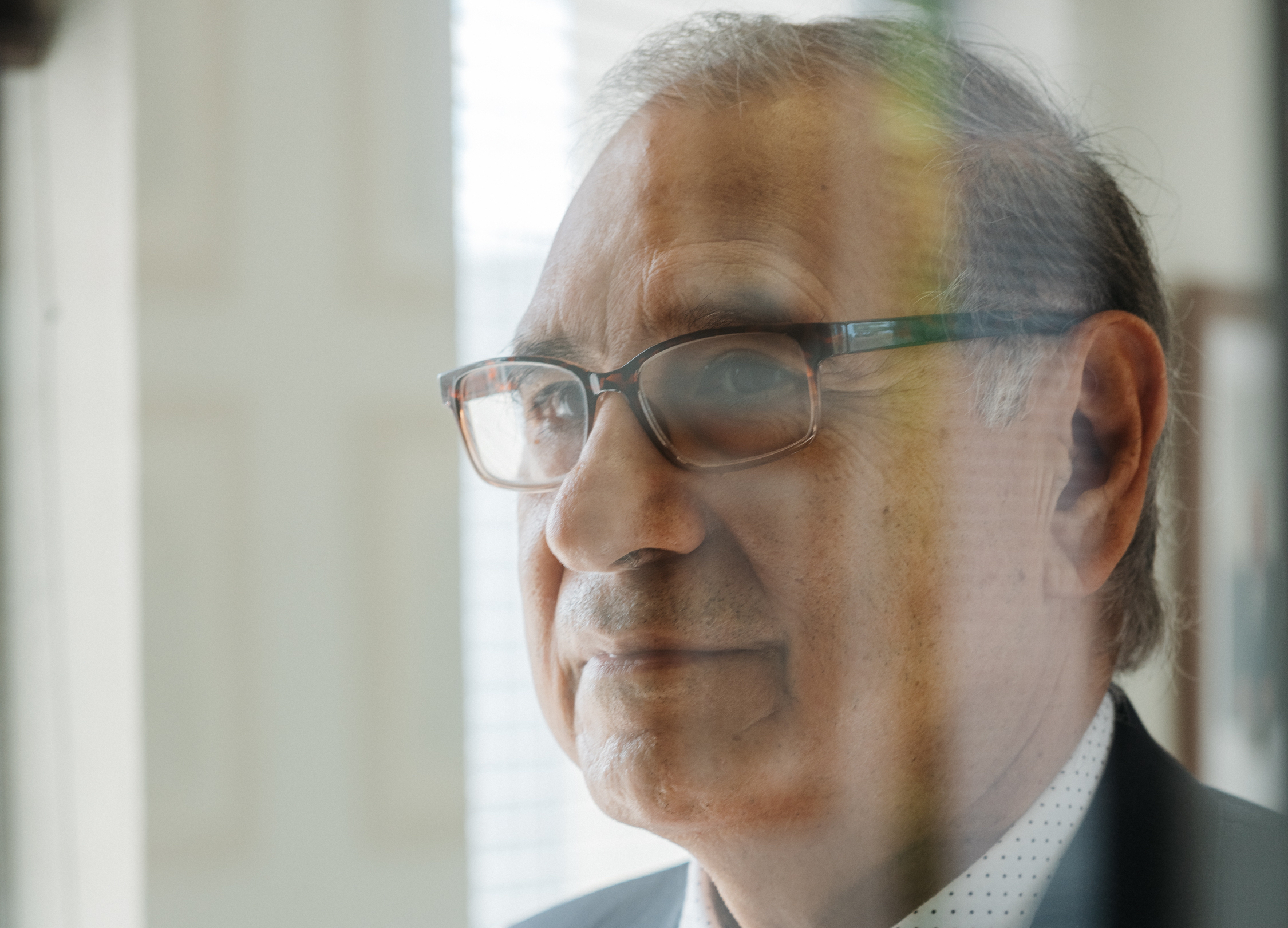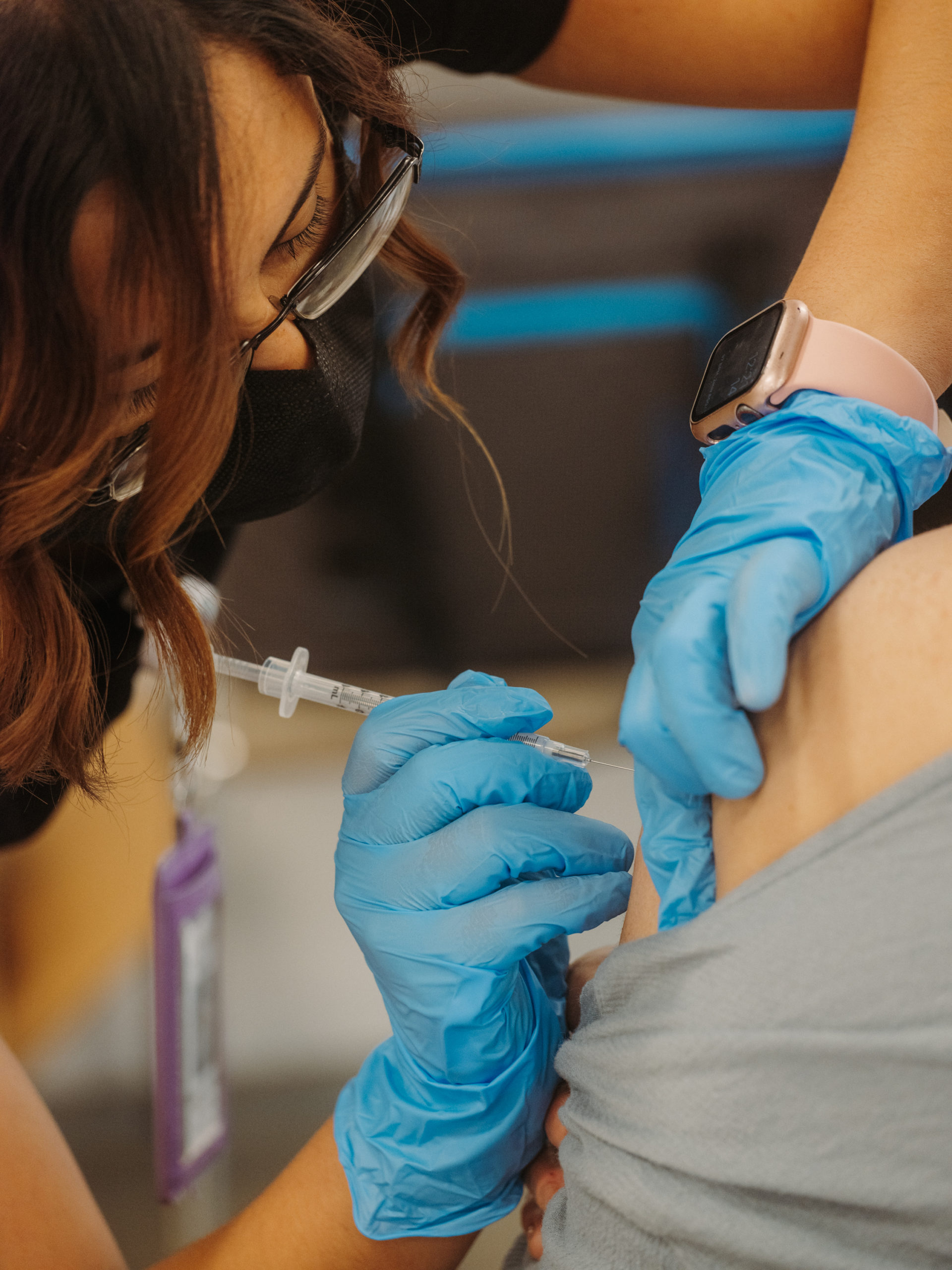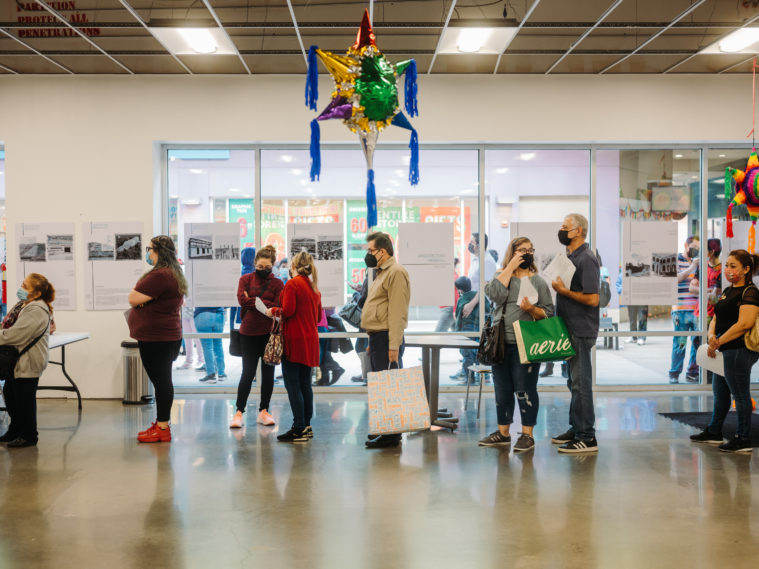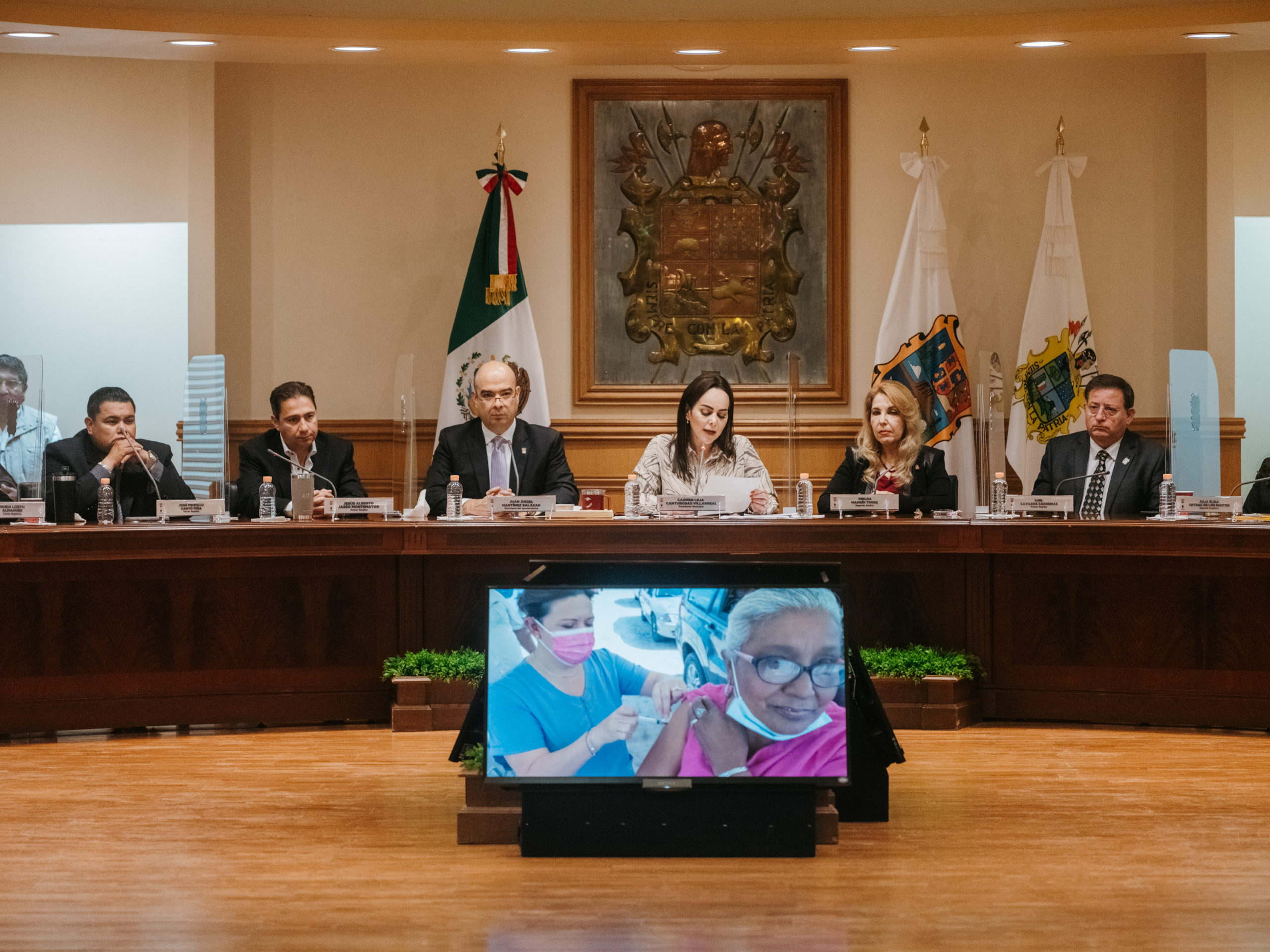An oxidized bronze statue of Tomás Sánchez, the founder of the bi-national metropolis Laredo, Texas, and Nuevo Laredo, Tamaulipas, Mexico, gazed upon the Presidencia Municipal on a warm sunny day in mid-December. Inside the building, Dr. Victor Treviño, one of Sánchez’s 10th-generation descendants and Laredo’s Health Authority, accepted the key to the city of Nuevo Laredo from Mayor Carmen Lilia Conturosas for his efforts to obtain and distribute free COVID-19 vaccines for its residents. The recognition was bittersweet for Dr. Treviño.
“It took a lot of effort founding these cities,” he said as he crossed the international bridge toward Mexico shortly before the ceremony. “Though Nuevo Laredo is another country now, the people are still the same. Now the bridge is open, and we need to vaccinate as many people as we can. Politics, government, the virus doesn’t respect that or the border.”
For the past 22 months, Dr. Treviño and his colleagues battled a deadly virus that brought overflowing hospitals, one of Texas’s worst death rates, and political fights with Governor Greg Abbott over local COVID-19 policies. Despite a deficit of pre-pandemic medical staff, Laredo emerged as a model for international and humanitarian cooperation.
In less than a year, Webb County, where Laredo is the seat of government, succeeded in fully vaccinating more than 87 percent of its population over age five. In Laredo, the largest land port in the United States, the hospitalization rate fell from one of the highest in Texas in August 2020 to one of the lowest.
However, with the Delta variant soon to sweep the globe, Dr. Treviño realized the need for a regional solution to the pandemic. The U.S. and other wealthy countries had prioritized vaccinating their citizens first, buying up much of the first rounds of supply—far more than their public demanded—and donating few vials to poorer nations. Even as the world clamored desperately for help, U.S. pharmacies and health departments threw away millions of expired doses.
“I knew a father and son, both anesthesiologists in Nuevo Laredo. Both died,” Dr. Treviño said. “A lot of doctors were not vaccinated, so we had to do something. We can’t let commerce go back and forth [across the bridge] without a plan.”

As Nuevo Laredo hospitals and clinics planned logistics to transport staff to the international bridge, Dr. Treviño and his son, Victor Treviño Jr. sourced extra doses from sources statewide. Soon, Treviño Jr. traveled to Houston and San Antonio, picking up vaccines in lots of 50 and 100.
With the vaccine in hand, Treviño Jr. walked over the international bridge to meet Mexico’s military. Heavily armed men put the Treviños in the back of an armored truck and drove to a nearby location where Nuevo Laredo medical workers jabbed their colleagues.
“We needed to ensure they were put in arms,” Treviño Jr. said. “The vaccines have such a high value in Mexico. We didn’t want them ending up on the black market.”
Dr. Karen Hernandez, who lives and practices medicine in Nuevo Laredo, volunteered to inoculate her colleagues with the Treviños’s salvaged doses. “It was a great experience,” she said. “I felt like a little grain of sand helping to stop the pandemic.”
After the successful word-of-mouth vaccinations for medical workers in Nuevo Laredo, Dr. Treviño quickly moved forward with a formal, regional vaccination plan.
Treviño, Laredo Health Director Richard Chamberlain, Fire Chief Guillermo Heard, and Mexican Consulate General Juan Carlos Mendoza planned a pilot program to immunize unvaccinated Mexicans entering the U.S. The officials identified truck drivers ferrying cargo multiple times daily between the cities—an obvious vector for spreading the virus—as their first target. Approximately 8,000 trucks cross the Rio Grande through the Laredos daily, carrying auto parts, electronics, medical equipment, and other mass-produced products.
“It was a basic principle promoted by Dr. Treviño,” said Mendoza, who helped with logistics. “We won’t be safe until we make a contribution to the people on the other side of the border.”
Starting in late July, hundreds of drivers received doses supplied by the Laredo Health Department inside the U.S. Border Patrol and Customs inspection site. With few traffic disruptions, local officials deemed the effort a success. Another round of cross-border talks began, led by Consul General Mendoza, between the mayors of Laredo and Nuevo Laredo and federal level officials on how and whom to vaccinate next.

Working with INDEX Nuevo Laredo, a trade association representing local maquiladoras, the Mexican Consulate in Laredo and Laredo city officials began the next program to vaccinate factory workers and their families in late July. They targeted assembly line employees to maintain an uninterrupted flow of goods across the border. Despite the pandemic, approximately $600,000 worth of goods per minute traveled through Laredo in 2020, according to the Consulado General.
The manufacturers bussed their employees to the Juárez-Lincoln International Bridge, which connects the two cities over the Rio Grande. At the bridge, contracted medical personnel injected 5,010 factory workers, including some of the workers’ children, with single-shot Johnson & Johnson vaccines. After a short, precautionary wait for adverse reactions in the air-conditioned buses, the workers returned to Mexico.
“Both sides of the border commingle for every type of situation,” Laredo Fire Chief Heard said. “The silver lining of the pandemic is it really brought our communities closer.”
In August, governor-elect of Nuevo León Samuel Garcia learned of the Laredo vaccine-sharing program. In Monterrey, one of Mexico’s most important economic cities—a three-hour drive south of Laredo in the border state of Nuevo León—the virus was spreading rampantly. The four million residents in the Monterrey metro area had little access to any vaccine. Garcia forged a partnership between Laredo and Monterrey maquiladoras similar to the Nuevo Laredo arrangement. Between August 18 and December 2, more than 33,000 factory workers from Monterrey traveled by bus to the border for vaccines donated by Larado’s health department, with logistics paid for by the Nuevo León government.
“It’s a shame to throw away vaccine that will save thousands of lives,” Dr. Treviño said. “Now that this program has momentum, governments will understand this is the only way to go.”
Indeed, after the vaccination of the Monterrey factory workers, Nuevo Laredo leaders asked for another vaccination drive for their teachers. The first five busloads of teachers crossed the Juárez-Lincoln bridge on December 6.
In the Customs and Border Patrol vehicle inspection area, first a small National Guard medical team, then seven medical workers from Dr. Treviño’s practice, overseen by Treviño Jr., vaccinated more than 11,000 teachers in ten days. “It took our people less than 10 minutes to vaccinate one bus,” Treviño, Jr. said of the rapid operation.
A week before Christmas, the last bus of the year returned to Mexico filled with newly vaccinated teachers.

Laredo has further broadened its effort to distribute vaccines. At the Outlet Shoppes mall—only a hundred yards from the international bridge in downtown Laredo—the Mexican Consulate opened a storefront to vaccinate anyone who walks up, most often Mexican nationals with U.S. entry visas. In front of the Puma store, the National Guard vaccinates, too. The city’s Department of Health keeps a jab site open beneath its administrative offices. Hundreds of men, women, and children lined up at all three locations through the holidays and into 2022.
“Mexicans are desperate for vaccines,” Treviño Jr. said—especially now with the highly contagious omicron variant seemingly everywhere. He met an 88-year-old man who rode a horse for nearly 52 miles from Anáhuac, Nuevo León, just for the jab. He met a woman who had just completed her last round of chemotherapy mid-bridge to administer a dose. Another woman was carried across the bridge for a vaccine at the Outlet Shoppes on a stretcher.
According to Consulate General Mendoza, more than 60,000 Mexican nationals, including 11,000 children, were vaccinated in Laredo by the end of 2021. Dr. Richard Chamberlain, the health department director, said the bridge bus operations will start again in January, which would allow visa-holding Mexicans to visit family, friends, and shop in the U.S. after receiving CDC-approved vaccines.
Dr. Treviño wonders if his city can get needles in arms fast enough to beat omicron and stop Nuevo Laredo patients from inundating Laredo hospitals. Already, the Laredos are detecting jumps in infections, and the monoclonal antibody treatments, effective against previous virus infections, are not effective against the new variant. The best way forward, the doctor said, is prevention: vaccines, masks, and maintaining 10-day quarantines for the infected.
“Providing the vaccine to everyone in the world is what is needed,” Dr. Chamberlain said. “We think about not only Texans but also our brothers and sisters in Nuevo Laredo, Tamaulipas.”








